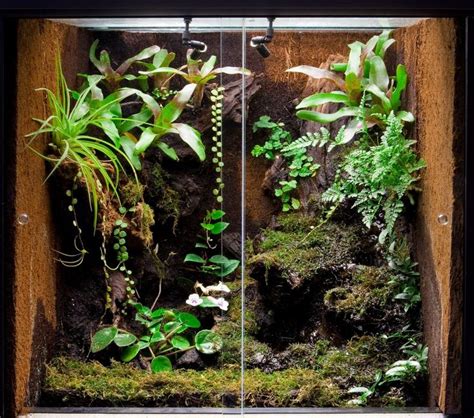Introduction
Bioactive terrariums are becoming increasingly popular due to the benefits they offer to both reptiles and amphibian keepers and the environment. These terrariums create a self-sustaining ecosystem by utilizing live plants, substrate, and beneficial organisms to maintain a balanced environment for the inhabitants. This detailed guide will provide you with a comprehensive understanding of bioactive terrarium designs, their benefits, and step-by-step instructions on how to create your biotope.

Benefits of Bioactive Terrariums
Bioactive terrariums offer a wide range of advantages compared to traditional setups:
-
Improved Animal Health: The balanced ecosystem promotes the growth of beneficial bacteria and fungi, which help break down waste, suppress pathogens, and create a healthier environment for the animals.
-
Reduced Maintenance: The self-sustaining ecosystem requires less frequent cleaning and maintenance, as the beneficial organisms help manage waste and decomposition.
-
Enhanced Aesthetics: The lush vegetation and natural elements create an aesthetically pleasing environment that is both visually appealing and stimulating for the inhabitants.
-
Educational Value: Bioactive terrariums provide an excellent opportunity to observe natural ecological processes in a controlled environment, enhancing the educational experience for keepers and visitors.
-
Environmental Sustainability: The use of live plants and natural materials promotes sustainability by reducing the need for artificial materials and excessive energy consumption.
Elements of a Bioactive Terrarium
A bioactive terrarium typically consists of the following elements:
-
Live Plants: Plants provide cover, breeding sites, and oxygen for the animals. They also assist in filtering toxins and regulating humidity levels.
-
Substrate: The substrate is a mix of organic and inorganic materials that provides drainage, support for plants, and habitat for beneficial organisms.
-
Beneficial Organisms: These include springtails, isopods, and earthworms, which break down organic matter, aerate the substrate, and contribute to the overall health of the ecosystem.
-
Hides and Basking Sites: Terrariums should provide ample hiding places and basking spots to meet the behavioral and physiological needs of the inhabitants.
-
Light and Heat: Lighting and heating systems are necessary to mimic the natural environment and provide the required conditions for the animals and plants.
Step-by-Step Guide to Creating a Bioactive Terrarium
Creating a bioactive terrarium involves several key steps:
-
Choose the Right Species: Select animals and plants that are compatible with the size and resources of the terrarium.
-
Prepare the Terrarium: Clean and disinfect the enclosure thoroughly to remove any contaminants.
-
Install the Substrate: Add a layer of drainage material, such as clay pebbles or leca, followed by the bioactive substrate.
-
Plant the Terrarium: Arrange the chosen plants in a visually appealing and functional manner.
-
Introduce Beneficial Organisms: Add a variety of beneficial organisms, such as springtails and isopods, to help establish the ecosystem.
-
Establish a Watering and Feeding Routine: Water the plants as needed and provide food for the animals in accordance with their dietary requirements.
-
Monitor and Adjust: Regularly observe the terrarium and make adjustments to the lighting, temperature, or humidity as necessary to ensure the well-being of the inhabitants.
Bioactive Terrarium Designs VS Traditional Setups
Substrate Comparison
| Substrate Type | Bioactive Terrarium | Traditional Setup |
|---|---|---|
| Composition | Organic materials (soil, leaf litter, bark) | Inorganic materials (gravel, sand) |
| Drainage | Excellent | Poor |
| Beneficial Organisms | Supports beneficial organisms | Does not support beneficial organisms |
| Maintenance | Minimal cleaning required | Frequent cleaning required |
Humidity Control
| Humidity Control | Bioactive Terrarium | Traditional Setup |
|---|---|---|
| Mechanism | Live plants, substrate moisture | Manual misting or humidifier |
| Stability | More stable | Less stable |
| Health Benefits | Promotes respiratory health in animals | Can lead to respiratory issues |
Animal Care
| Animal Care | Bioactive Terrarium | Traditional Setup |
|---|---|---|
| Disease Prevention | Reduced risk of disease | Higher risk of disease |
| Behavior | Naturalistic behavior encouraged | May result in unnatural behaviors |
| Enrichment | Variety of hiding places and activities | Limited enrichment options |
Future Trends and Innovations in Bioactive Terrarium Designs
The field of bioactive terrarium design is continuously evolving, with new and innovative approaches emerging. Some potential future trends include:
-
Smart Technology Integration: Smart devices can be used to monitor and automate environmental parameters, making terrarium management more efficient and convenient.
-
Advanced Lighting Systems: LED lighting systems can provide more precise and energy-efficient illumination, allowing for better plant growth and animal well-being.
-
Novel Substrate Combinations: Researchers are experimenting with new substrate combinations that optimize drainage and support the growth of beneficial organisms.
-
Custom Ecosystems: Terrarium designers are creating custom ecosystems tailored to specific species, providing highly specialized and naturalistic environments.
By embracing these future trends, bioactive terrarium designs will continue to enhance the well-being of animals and plants while offering a sustainable and enriching educational experience.
Market Insights and Key Players
The bioactive terrarium market is experiencing steady growth due to increasing awareness of their benefits. Key players include:
-
Exo Terra: A leading manufacturer of terrarium equipment and supplies, including bioactive substrates and enclosures.
-
Josh’s Frogs: A specialty retailer that offers a wide range of bioactive terrarium products, including live plants and beneficial organisms.
-
ReptiZoo: A distributor of terrarium products, including bioactive substrates and lighting systems.
-
The Bio Dude: A company specializing in the production of bioactive substrates and other terrarium supplies.
-
Natures Way Enclosures: A manufacturer of custom bioactive terrariums for a variety of species.
Conclusion
Bioactive terrarium designs are revolutionizing the way we keep reptiles and amphibians in captivity. By creating self-sustaining ecosystems that mimic natural environments, bioactive terrariums provide numerous benefits for both the inhabitants and the keepers. This guide has provided a comprehensive overview of the elements, design principles, and future trends of bioactive terrariums. By embracing these innovative approaches, we can create thriving and sustainable ecosystems that enhance the well-being of our animals and contribute to our understanding of natural ecological processes.





















